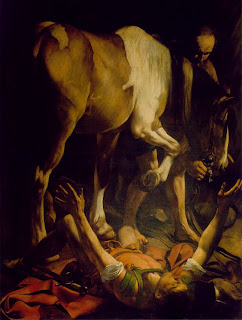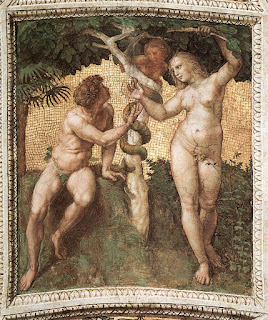The meaning of the figures on the antique relief in the center of Titian’s Sacred and Profane Love has eluded scholars for centuries. In this post I would like to discuss the horse so prominently depicted on the left side of the relief.
In my paper on the Sacred and Profane Love I argued that the subject of the mysterious painting is the “Conversion of Mary Magdalen,” and that the figures on the antique relief must not only refer to the subject of the painting, but also, must be depictions of great sinners.
In my previous two posts I elaborated on my discussion in the paper and looked at the right side of the relief where we can now identify Adam and Eve as well as Cain and Abel. On the left side of the relief we can see a horse whose rider appears to be falling off. We can also make out two other men in front of and in back of the horse. *
Why has no one ever seen the conversion of St. Paul in this scene? Anytime, we see a riderless horse in a painting from the Renaissance we should suspect that the artist has attempted to depict the famous conversion on the road to Damascus. Here is the account of Paul’s conversion from chapter 9 of the Acts of the Apostles:
And as he went on his journey, it came to pass that he drew near to Damascus, when suddenly a light from heaven shone round about him; and falling to the ground, he heard a voice saying to him, “Saul, Saul, why dost thou persecute me?” And he said, “Who art thou, Lord?” And he said, “I am Jesus, whom thou art persecuting. It is hard for you to kick against the goad.” And he, trembling and amazed, said, “Lord, what wilt thou have me do?” And the Lord said to him, “Arise and go into the city, and it will be told thee what thou must do.” Now the men who journeyed with him stood speechless, hearing indeed the voice, but seeing no one. And Saul arose from the ground, but when his eyes were opened, he could see nothing. And leading him by the hand, they brought him into Damascus.
Although there is no mention of a horse in the scriptural account, it had become part and parcel of the story as early as the fourth century despite the objection of St. Augustine who argued that a Pharisee would never ride a horse. By the Renaissance the horse had become part of the common Catholic imagination and was usually included in artistic representations.
For our purposes other important parts of the account would be the light from heaven that shone round Paul and forced him to fall to the ground. The voice of Jesus is heard but he does not appear. Also, Paul is accompanied by other men who hear the voice but stand by as speechless spectators.
In Titian's relief Paul is actually falling off the horse's hind quarters. One attendant can be seen in front of the horse, and another tries to prevent Paul's fall at the rear.
Everyone is familiar with Caravaggio’s famous depiction of the event that still remains in its original location in the Cerasi chapel of S. Maria del Popolo in Rome. Paul lies on the ground, arms upraised toward the light and the horse towers over him.
 |
| Caravaggio: Conversion of Paul |
Other depictions of the event often present a more tumultuous scene but still include the light, the other men, and the horse. These elements must have been commonplace even before the sixteenth century. Here is a famous tapestry made from a Raphael cartoon.
 |
| Tapestry from Raphael cartoon |
Early in his career Giovanni Bellini also depicted the conversion of Paul.
 |
| Giovanni Bellini: Conversion of Paul |
I know that Renaissance artists loved to depict horses but when we see a riderless horse in a seemingly inexplicable scene, we should at least consider the possibility of the conversion of Paul.
There is more than one reason why Titian or his patron might have wanted to include St. Paul in a painting representing the conversion of Mary Magdalen. The conversion stories of both saints were equally famous. At the same time, they were both symbols of sinners converted by divine love.
In researching this piece I turned to the always reliable Emile Male. In his magisterial study of later Medieval art Male re-discovered two extremely popular books of the fifteenth century that have subsequently slipped back into oblivion. The first was the Ars moriendi (the Art of dying):**
The text was often striking, but it is the astonishing woodcuts above all that spread its fame throughout Europe….death appears not as a farcical dance, but as a serious drama played around the bed of the dying man; angel and devil stand at his side, contending for the soul that will soon depart...
The success of the Ars moriendi was even more extraordinary than the success of the Danse Macabre. Printed editions began to appear after the woodcut editions. Each country had its own… It appeared in turn in French, German, English, Italian, and Spanish….Even Italy, where Gothic barbarity was so scorned, was influenced by the crude woodcuts of the Ars moriendi, although it is true it robbed them of most of their original character.
The other book was a commentary on the Ars moriendi in an edition published by Verard entitled "L’Art de Bien Vivre et de Bien mourir (The Art of Good Living and Good dying)." Male noted that a "book that edified all Europe is worth some study."
Verard's commentary includes a number of episodes with corresponding woodcuts where devils and angels compete for the soul of the dying man. In one episode Mary Magdalen and St. Paul appear with St. Peter and the Good Thief to console the dying man.
When the devil cannot shake the dying man’s faith, he changes tactics. He no longer denies God, but represents him as inexorable... Hideous monsters again rove around the sick man’s bed. One presents him with a large parchment document: this is the list “of all the evils that the poor creature has committed during his sojourn on earth.”…
The angel again descends from heaven, accompanied by four saints. They are St. Peter, who thrice denied his Master; Mary Magdalene, the sinner; St. Paul, the persecutor whom God struck down to convert him; and the good thief, who repented on the cross. These are the great witnesses of divine mercy….
The woodcut shows Mary Magdalene with her jar of ointment and St. Paul is shown atop the fallen horse. the woodcut is dated 1492. In the same year (1514) that Titian painted the Sacred and Profane Love Raphael painted his depiction of St. Cecilia surrounded by four saints. In front, flanking St. Cecilia, are St. Paul with his sword of truth, and Mary Magdalen with her jar of ointment.
 |
| Raphael: St. Cecilia with St. Paul and Mary Magdalen |
###
*This series of posts first appeared on Giorgione et al... in the Spring of 2013. The original paper was first published in 2011.
**Emile Male, Religious Art in France, The Late Middle Ages, Princeton, 1986, pp. 348-351.







